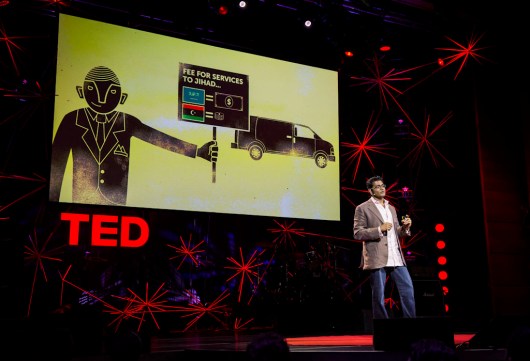Photo: James Duncan Davidson
Shyam Sankar, a data intelligence agent working at Palantir, leads off his talk with two games of chess. In 1997 Gary Kasparov lost to Deep Blue, a machine. It was an event remembered by many as a pivotal moment in the relationship between humans and computers. “To many, this was the dawn of a new era, where man would be dominated by machines.” But, argues Sankar, that’s not what happened, “Twenty years later, the greatest change to how we relate to computers was the iPad, not HAL.”
The second chess match was in 2005. In this match, humans and computers could collaborate if they liked. Who won? It wasn’t a grandmaster with a supercomputer, but a couple of amateurs with a few laptops. They were able to counter both the skill of grandmasters and the power of supercomputers by finding the right way to cooperate with the machines — to guide the computers to the right answer.
We’ve been paying attention to a certain vision of artificial intelligence, Sankar says, and it’s a sexy and compelling one. But there’s an alternative vision: J.C.R. Licklider‘s notion of intelligence augmentation. He wanted humans and machines to cooperate. The idea is that humans are great at certain things, like creativity and intuition. Computers are great at calculation, scale and volume. So, “The idea is not to take a toaster and make Data from Star Trek, but to take a human and make her more capable.”
This approach has been making extraordinary advances. The now classic example is protein folding. How do you tell from a gene sequence what the final protein will look like? This is an extraordinarily difficult problem, both for computers, because of the uncomputably vast number of possible foldings, and for humans, because of the complex calculations needed to tell if a particular folding is correct. The answer was a game, called Foldit. Humans arrange the molecules, and the computers take care of the complex calculations. Working together with a computer, non-experts beat super-computers 50% of the time.
As another example, the 9/11 Memorial opened recently. It displays the names of the victims based on the relationships to each other — an arrangement called meaningful adjacency. That’s a very complicated problem, and one solved elegantly by similar cooperative techniques. Originally, the credit was given to an algorithm, but in fact humans used the computer to manage the design — letting the computer doing the calculations, while they provided the aesthetics and final decisions.
What can we do to improve human-computer symbiosis? Sankar’s answer: “Instead of thinking how the computer can solve the problem, design the process around what the human can do with it.” This leads to a surprising revelation: “When you do this, you’ll find you spend most of your time on the interface.” The most important factor in these interactions is minimizing the friction at the interface.
Another example: Big Data. There is an enormous amount of data being generated, and it appears overwhelming, even dehumanizing. In contrast to that view, Sankar believes this is an opportunity to understand the human condition. Most of the focus now is on how to store, compute, and analyze. But “the imperative isn’t how to compute, but what to compute.” And that is the avenue that can lead to greater human understanding.
Computers can’t find patterns they’ve never seen, he says: “You cannot algorithmically data-mine your way to an answer.” Humans will have to search for insight with help from machines. “To some this has terrifying privacy and civil liberties implications. To others, it’s a new era of greater privacy and civil liberties protection.”
Data-mining techniques have also been used to help in the fight against terrorists. Like any fighters, terrorists are always adapting tactics, and these adaptions are fundamentally human. In October 2007, the United States raided an Al-Qaeda house, where they found a treasure trove of documents: human resources forms. (He notes: “Al Qaeda is not without its bureaucracy.”) The forms recorded things like the recruit’s hometown, travel route, who recruited them, and what job they wanted.
Surprisingly, the number 1 job requested? Suicide bomber. Somewhere inside these documents was a way to understand the problem, and stop a major source of instability in the region. These were complex PDF documents — there was no time for humans to simply read them all in sequence, so they used computers to parse the data they contained. They were able to deconstruct the recruitment networks, and found ways to disrupt them.
After the earthquake in Haiti, the only institution with knowledge of floodplains was leveled. So how could relief agencies put together that data to decide how to respond? How could they find which camps needed help the most? They had to put together data from disparate places over the internet. A job that would have required 40 people over three months, became a job for just a few people in hours — a major success for human-computer symbiosis.
Far from the vision of computers dominating humans, Sanker suggests, “We should be tackling this century’s problems as man and machine, cooperating together.”

Comments (6)
Pingback: AI and Surveillance: Are SRI, Palantir and BRS Labs “Summoning the Demon”? - Insider Surveillance
Pingback: Looking forward, looking back: TEDGlobal 2012 recap - Entrepreneur News | Australian Society of Entrepreneurs
Pingback: 85500 Creative Technologies: Week 2 « chegg.
Pingback: The story behind the slides: Palantir’s presentation at TEDGlobal 2012 - Entrepreneur News | The Australian Society of Entrepreneurs
Pingback: The story behind the slides: Palantir’s presentation at TEDGlobal 2012 | Indoor Digital Billboards
Pingback: The story behind the slides: Palantir’s presentation at TEDGlobal 2012 | Krantenkoppen Tech